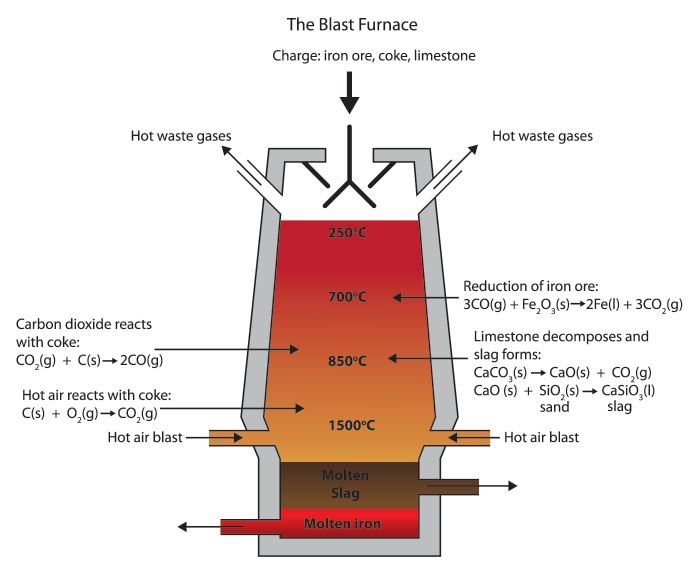
Draw a neat diagram of the blast furnace used in the extraction of iron and label the parts.
Answer
583.8k+ views
Hint: Iron is extracted from iron ores such as haematite contain iron(III) oxide, ${ Fe }_{ 2 }{ O }_{ 3 }$ in a huge container called a blast furnace. Now you should try to answer this question.
Complete step by step solution:
We should know that Carbon is more reactive than iron, so it can displace iron from iron(III) oxide. Here we can see the equations for the reaction:
${ 2Fe }_{ 2 }{ O }_{ 3 }(s)+3C(s)\rightarrow 4Fe(l)+3CO_{ 2 }(g)$
The blast furnace is so hot that carbon monoxide can be used, in place of carbon, to reduce the iron(III) oxide:
${ Fe }_{ 2 }{ O }_{ 3 }(s)+3CO(s)\rightarrow 2Fe(l)+3CO_{ 2 }(g)$
Now, we will discuss the reaction involved in removing the impurities.
The calcium carbonate or we can say the limestone thermally decomposes to form calcium oxide.
$CaCO_{ 3 }(s)\rightarrow CaO(s)+CO_{ 2 }(g)$
The calcium oxide formed will then react with silica impurities in the haematite, to produce slag (calcium silicate). This reaction is a neutralization reaction because calcium oxide is basic and silica is acidic.
$CaO(s)+SiO_{ 2 }(g)\rightarrow CaSiO_{ 3 }(l)$
This diagram below represents the temperatures required for each reaction to proceed successfully -

Note: We should know that the molten iron from the bottom of the furnace can be used as cast iron. It is very runny when it is molten and doesn't shrink much when it solidifies. It is therefore ideal for making castings as the name suggests.
Complete step by step solution:
We should know that Carbon is more reactive than iron, so it can displace iron from iron(III) oxide. Here we can see the equations for the reaction:
${ 2Fe }_{ 2 }{ O }_{ 3 }(s)+3C(s)\rightarrow 4Fe(l)+3CO_{ 2 }(g)$
The blast furnace is so hot that carbon monoxide can be used, in place of carbon, to reduce the iron(III) oxide:
${ Fe }_{ 2 }{ O }_{ 3 }(s)+3CO(s)\rightarrow 2Fe(l)+3CO_{ 2 }(g)$
Now, we will discuss the reaction involved in removing the impurities.
The calcium carbonate or we can say the limestone thermally decomposes to form calcium oxide.
$CaCO_{ 3 }(s)\rightarrow CaO(s)+CO_{ 2 }(g)$
The calcium oxide formed will then react with silica impurities in the haematite, to produce slag (calcium silicate). This reaction is a neutralization reaction because calcium oxide is basic and silica is acidic.
$CaO(s)+SiO_{ 2 }(g)\rightarrow CaSiO_{ 3 }(l)$
This diagram below represents the temperatures required for each reaction to proceed successfully -

Note: We should know that the molten iron from the bottom of the furnace can be used as cast iron. It is very runny when it is molten and doesn't shrink much when it solidifies. It is therefore ideal for making castings as the name suggests.
Recently Updated Pages
Why are manures considered better than fertilizers class 11 biology CBSE

Find the coordinates of the midpoint of the line segment class 11 maths CBSE

Distinguish between static friction limiting friction class 11 physics CBSE

The Chairman of the constituent Assembly was A Jawaharlal class 11 social science CBSE

The first National Commission on Labour NCL submitted class 11 social science CBSE

Number of all subshell of n + l 7 is A 4 B 5 C 6 D class 11 chemistry CBSE

Trending doubts
Differentiate between an exothermic and an endothermic class 11 chemistry CBSE

10 examples of friction in our daily life

One Metric ton is equal to kg A 10000 B 1000 C 100 class 11 physics CBSE

Difference Between Prokaryotic Cells and Eukaryotic Cells

State the laws of reflection of light

Explain zero factorial class 11 maths CBSE




